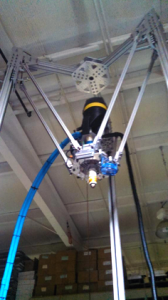There were a number of striking behemoths strewn around the expansive NYC Hall of Science fairgrounds. Each sky-eclipsing landmark added emphatic punctuation to the grandiose visual statement of the World’s Maker Faire last weekend. Among giant rocket ships, dragons, cardboard robots and mammoth Disney characters, there was one 3D printer that towered above fresh crowds of awe-struck makers and attendees: SeeMeCNC’s PartDaddy. Makers, parents, children, superheroes, robots and androids alike stopped in their tracks to gaze upon the thick streams of plastic, extruding various objects into existence right before their eyes.

The Part Daddy is indeed a beast of a Delta printer. At 16.2’ tall, the Part Daddy can also print almost anything that melts at 300-350° Celsius. It has a 4 ft. print bed, and can print objects up to 11 ft. high. Usually, the PartDaddy is printing directly from the same resin pellets that most filaments are derived from. Don’t feed the monster any spools of filament. Printing from pellets cuts the cost of ordering or manufacturing a thicker custom filament, to fit into its 6.35 mm and 7.25 mm nozzles.

slot design of the Rostock MAX. Using a standard t-slot aluminum extrusion system lowers the cost and increases the accessibility for anyone to build his or her own machine. Riding on one side of the eccentric cams are bearings covered by plastic sleeves. An even force is applied between the bearing and the t-slot rail, thanks to the inclusion of spring tensioners on the carriage roller bearings. 3-inch vertical square t-slot rails allow for linear motion, while the smaller 1 inch square t-slot rails are used for each of the six arms, creating an optimized balance of rigidity and weight.
Though the Part Daddy can print objects faster than most extrusion printers, the downside of the large nozzle size is a less accurate resolution. At the demonstration, however, the objects they chose to print were coming out perfectly.
So, just what are the origins of the PartDaddy moniker? Just ask Mr. Part Daddy himself. No, this 3D printer does not have voice recognition software built-in, although that would be cool (this means you, James Earl Jones). “Part Daddy” is the nickname of Steve Wygant, founder of Blackpoint Engineering LLC. Steve does not have the voice of Darth Vader, but he appears to be as intuitive with building machines as a young Anakin Skywalker. A long time ago (1996) in a galaxy far, far away (Goshen, Indiana) Steve started a machine shop called Blackpoint Engineering, LLC, and spent the next few years there making medical instruments followed by many years of manufacturing paintball parts. In 2011, Blackpoint Engineering started doing business as SeeMeCNC. But Mr. “Part Daddy” himself was not alone at Maker Faire. John “Oly” Olfason, was by his side, and they couldn’t have made a more dynamic duo. According to the biography posted on SeeMeCNC’s website, John “was born in Seattle, Washington, somehow got lost, and ended up in northern Indiana, looking for something to hack on.” However serendipitous his entry was into the SeeMeCNC fold, the Part Daddy is proof positive that the collaboration between Steve and John is a fruitful one.
That covers the names and the origins of the makers, but where did the idea to build this colossal printer come from? Simple. A client asked Steve and John to create a rocket in one print that exceeded the build volume of their largest Orion Delta printer. Apparently, when you ask Steve and John to build a massive 3D printed object, they will make it happen, even if it means building the largest Delta 3D printer in the world.
The birth of large-scale 3D printing has come to light in several industries over the last few years. Although large-scale printers are capable of producing amazing prints relevant to a wide variety of industries, we’ve seen a number of surprising applications in architecture and construction, most recently with Andrey Rudenko’s 3D printed castle appearing out of the Minnesota ether. Don’t forget about Enrico Dini, James Wolff and Adam Kushner of D-Shape Enterprises (printing a mansion in Gardiner NY beginning in January), Dr. Koshnevis with his robot-printer hybrid at USC, and Win Sun and Ma Yihe’s achievement, printing 10 houses in one day earlier this year in China.
In Europe, a few companies have massive 3D printers in their possession. Dutch architect firm Dus Architects recently reported that their Kamer Maker (filament) printer is now printing 3 times as fast, and is ready for placement on location to begin printing the Canal House Project. Across the border, Germany is home to companies such as Voxeljet (sandstone, plastic, chemical binding agents) and BigRep (filament), which have printers capable of large-scale applications in architecture and construction.

Where does PartDaddy fit in? Right now, its only global competitors using filament or pellets are the Kamer Maker and the BigRep. In America, it stands alone. But it certainly had plenty of company at the World’s Maker Faire. As far as I could tell, there were no mechanical issues with it. In fact, the only gasping and sputtering to be heard was coming from the crowd, blustering with terms of awe and amazement at SeeMeCNC’s elephantine printer. They call it the PartDaddy.
I guess it sounded better than the “Steve.”



